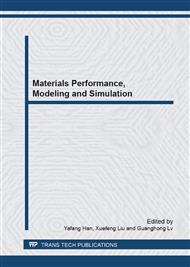[1]
P. Rodgers, V. Eveloy, M.G. Pecht, Limits of air-cooling: status and challenges, Semiconductor Thermal Measurement and Management Symposium, 2005 IEEE Twenty First Annual IEEE. (2005) 116-124.
DOI: 10.1109/stherm.2005.1412167
Google Scholar
[2]
D.B. Tuckerman, R.F.W. Pease, IEEE Electron Dev Lett. (1981) 2-126.
Google Scholar
[3]
P. Rosa, T.G. Karayiannis, M.W. Collins, Single-phase heat transfer in microchannels: The importance of scaling effects, Appl Therm Eng. (2009) 29-3447.
DOI: 10.1016/j.applthermaleng.2009.05.015
Google Scholar
[4]
X. Wei, Stacked micro-channel heat sinks for liquid cooling of microelectronic components, J Electron Packaging. 126(2004)60-66.
DOI: 10.1115/1.1647124
Google Scholar
[5]
T. Ogushi, H. Chiba, H. Nakajima, Measurement and Analysis of Effective Thermal Conductivities of Lotus-Type Porous Copper, J Appl Phys. 95 (2004) 843-5847.
DOI: 10.1063/1.1691188
Google Scholar
[6]
H. Chiba, T. Ogushi, H. Nakajima, Steady state comparative-longitudinal heat flow method using specimen of different thicknesses for measuring thermal conductivity of lotus-type porous metals, J Appl Phys. 103 (2008) 013515-013515-9.
DOI: 10.1063/1.2830843
Google Scholar
[7]
Y. Liu, Y.X. Li, H.W. Zhang, Pressure Condition for Formation of Lotus-Type Regular Porous Structure and Evolution of Pore Size, Acta Metall Sin. 41(2005)886-890.
Google Scholar
[8]
Y.X. Li,Y. Liu, H.W. Zhang, Proceedings of MetFoam 2005, Sendai: The Japan Institute of Metals (2006).
Google Scholar
[9]
H.W. Zhang, Y.X. Li, Y, Liu, Evalution of Porosity in Lotus-Type Porous Cu Fabricated with GASAR Process, Acta Metall Sin. 42 (2006) 1165-1170.
Google Scholar
[10]
H.W. Zhang, Y.X. Li, Y, Liu, Gas Pressure Condition for Obtaining Uniform Lotus-Type Porous Structure by GASAR Process, Acta Metall Sin. 42 (2006) 1171-1176.
Google Scholar
[11]
T. Ogushi, H. Chiba, H. Nakajima, Proceedings of MetFoam 2005, Sendai: The Japan Institute of Metals (2006).
Google Scholar
[12]
H. Chiba, T. Ogushi, H. Nakajima, Proceedings of MetFoam 2005, Sendai: The Japan Institute of Metals (2006).
Google Scholar
[13]
L.T. Chen, H.W. Zhang, Liu Y, Experimental Research on Heat Transfer Performance of Directionally Solidified Porous Copper Heat Sink, Acta Metall Sin. 48 (2012) 329-333.
DOI: 10.3724/sp.j.1037.2011.00703
Google Scholar
[14]
X.S. Lu, Numerical Simulating Liquid of metal Current (GaInSn) in Fault Current Limiter. Master's thesis, Nanjing University (2008).
Google Scholar


